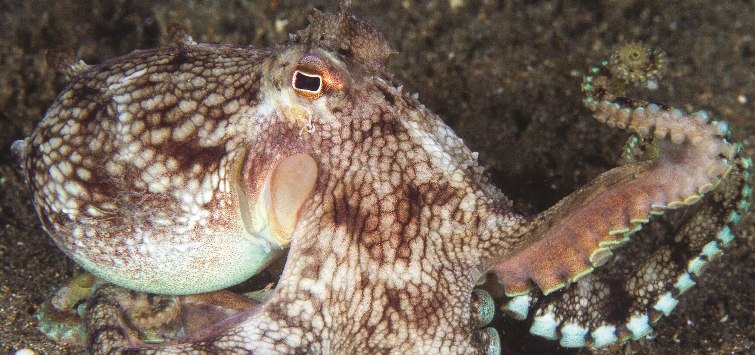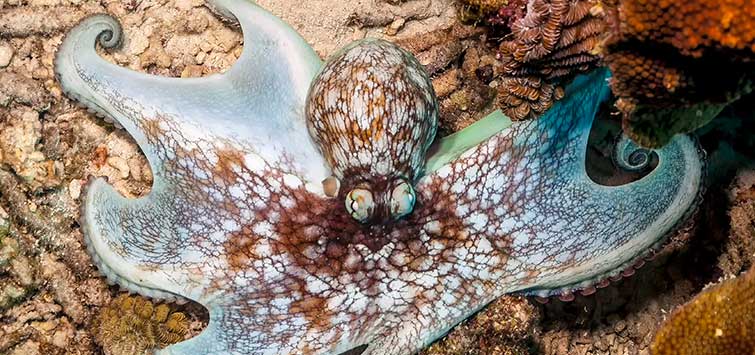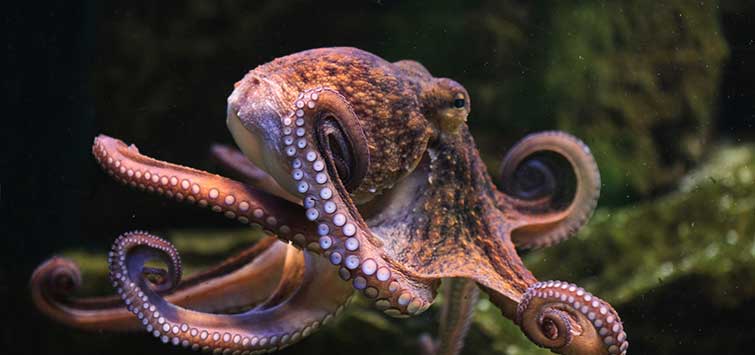Our Octopus Diving Adventures
Most people who are interested in underwater animal life are especially drawn to octopuses, particularly those lucky enough to have encountered one while snorkeling or diving. Whenever my husband Marc and I have come across an octopus in the wild, it has been an unforgettable experience.
We come across these curious creatures regularly on our shallow dives, including excursions down rocky walls, along debris fields, over muck, and on coral reefs. No matter how many times we see them, it’s always a treat. You’d think after countless octopus diving trips we’d be used to seeing them, but we get excited every time.
Octopuses can be tucked away in crevices to the point where all you see are their white-rimmed suckers, or they can be out and about, perched on the mud or hunting on the reef. Sometimes they are buried in debris with just their eyes peering through. We have even seen them completely rolled up in kelp, where only their distinctive outline gives them away.
They can be hard to spot at first, as they are quite good at camouflage. They often give away their position by moving just as we swim over, typically pulling in their arms or eyes to make themselves seem small, which is how we spot them.
Making Contact
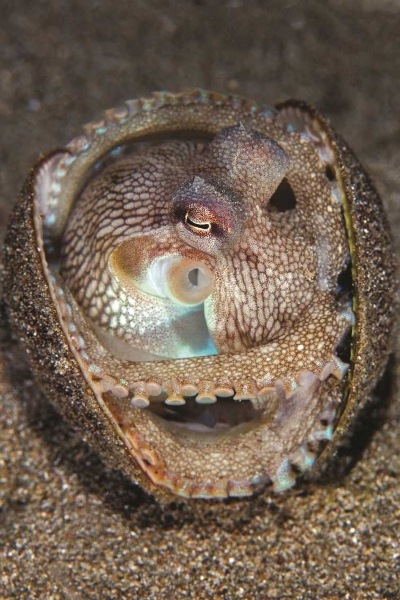
They love the taste and feel of gloves and dive lights. I like to put out a hand and let them reach me with the tip of their arms, which feel muscular and firm. Sometimes the octopus will approach and engulf your hand or wrist with several arms at once. This can be frightening at first, as they are very strong and fast. It’s like being squeezed by a very tight sock!
Most octopuses are not large enough to cause any harm, except for the giant Pacific octopus, one of which once stuck itself to my face. An arm tip got between my lips and the mouthpiece of my regulator, dislodging my mask in the process. This octopus was big, with suckers the size of dinner plates. Fortunately, my dive buddy was there to push the octopus gently upward, and it released me.
Octopuses also have very good eyesight, and they like to keep one eye on you at all times. Sometimes we play peek-a-boo with them, hiding behind a rock, kelp frond, or piece of coral, which they seem to love. They also like to feel your bubbles as you exhale.
Whenever a wild animal feels safe enough to explore a diver, it is an experience to be cherished, and this seems even more true with octopuses. I treasure every minute we’ve spent in their presence. Even though they don’t live very long, they will recognize individual divers and can form a kind of friendship with them.
We have been lucky to dive the same site and see the same giant Pacific octopus repeatedly for two years. She became very comfortable with us and would swim out of her den when we approached. She would hunt while we watched, putting her arms into cracks and the mud to pull out tasty clams and mussels. When she caught prey, her body would flash white, and she would often sit in front of us while she pried the shells open.
Octopuses can change shape, color, and even texture in the blink of an eye. This allows them to quickly change their silhouette, greatly enhancing their camouflaging ability. We have watched octopuses go instantly from looking hairy to completely smooth, or from white to rippling yellows and purples. We have also witnessed how flexible their boneless bodies are, stretching long and thin when they jet away or becoming large and round when they think a predator is near.
Their bizarre appearance isn’t the only reason that people are so fascinated with these boneless creatures. Their intelligence and curiosity really makes them fascinating animals. We’ve watched ruby red octopuses grab sheets of kelp to wrap themselves in to hide, and use our dive lights, which point out fish and other prey, to hunt.
During one octopus diving trip at night, we had a coconut octopus follow us on the sand until we stopped to photograph a squid. Once we had it in our lights, the octopus threw itself over the tiny squid, engulfing it with its mantle. It sat there as the squid pushed and struggled, so we took pictures of the octopus instead. Coconut octopuses will turn unique colors in front of divers, rimming their purple arms with bright blue lines. We watched this one flash its blue arms while it ate. Not only was it not afraid of divers, but it seemed to favor us after learning that we will point out food items!
Mating Habits of the Multi-Armed
We were lucky to chance upon a mating giant Pacific octopus pair when we were diving. This event is rarely seen. We watched for 20 minutes as the smaller male crawled over the wall and entered the large rock crack where the female was waiting. She was much bigger than him and very large, even for such a large species.We didn’t know if she would accept him at first, and we also knew that she could kill him if she wanted. Instead, she shrank back into the crack a bit, and he crawled in. Soon their arms were entwined, and they stayed crammed in between the rocks like that until we left.
After laying her clutch, the female octopus does not leave her eggs, instead sticking around to oxygenate them with jets of water from her siphon. This means she cannot eat, and she dies soon after her eggs hatch. The male dies shortly after mating as well, and he has no contact with the eggs or offspring.
This is sadly typical for octopuses, as they live tragically short lives. That means, unlike most highly intelligent animals, baby octopuses don’t learn anything from their parents. They have to discover how to hunt and navigate their surroundings all on their own, each generation starting without any knowledge taught by the previous one.
Hunter-Gatherers
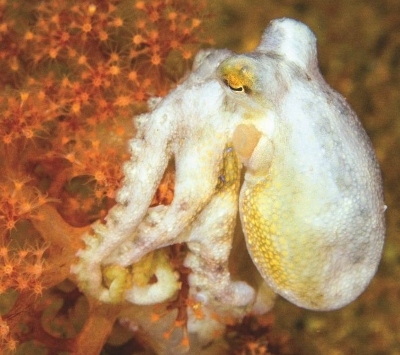
We often find giant Pacific octopus dens when diving along a rocky wall with deep crevices located near our home in British Columbia. We go very slow, looking for the gleam of bright white shells against the black rock. Since it is a vertical surface, the shells fall down the wall like a waterfall, and you can follow the trail to the den.
We’ve found crab shells, mussels, oysters, and snail shells littered around dens. Rock fish and sculpins hang around the den to feast on the leftovers, so if you’re looking for a lair, keep an eye out for scavengers too. The area will be clean of sea urchins and seaweed. Often the octopus is home and sitting near the edge of the den. Sometimes they will come out to say hello, but they usually shrink back a little and show you their white suckers.
Once we came upon a den, but the octopus inside wouldn’t move at all. We sat and waited, wondering if it might be ill. Suddenly, crabs came scuttling out from under its arms, running for their lives. The octopus shot out its arms to collect the fleeing crabs, and we could see another five under its large pink mantle. Not only had we found its den, but we found its pantry as well!
Cephalopods grow very fast, so it is crucial that they learn to find prey and hunt successfully from an early age. They must consume large amounts of food, and what they eat depends on the size and species of octopus. Giant Pacific octopuses and common octopuses love crabs and shellfish, while the smaller species eat small fish, shrimp, and other small invertebrates.
They hunt by crawling along the ocean floor and searching with their sucker-covered arms. Those suckers have chemoreceptors that can “smell” and “taste” their environment. Octopus suckers are extremely flexible, even able to fold in half, and incredibly strong, able to pry open clams and other kinds of shellfish with ease.
When you are gripped by one of their suckers, you realize how strong each one really is. They may even leave behind “octo-hickeys,” round marks on your skin. They need to be strong to kill their prey. When a food item is found, an octopus will surround it with their mantle, trapping it. Then they bite, injecting venom, which usually contains a paralytic compound that immobilizes their prey while they eat it.
While octopuses are venomous, most are harmless to human beings. Octopus mouths are very small and tucked way up under their mantle. It would be hard to get bit unless you are handling the animal aggressively. The blue ring octopuses of the genus Hapalochlaena are the rare exception—though they have caused very few human deaths, they should be avoided at all costs.
Masters of Disguise
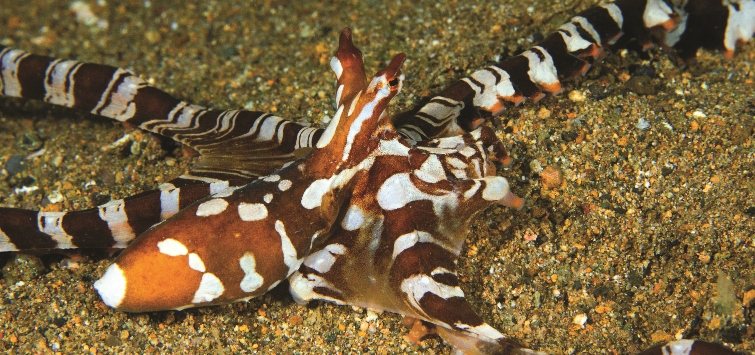
Cephalopods use their amazing skin to display to others and to camouflage themselves. If you haven’t seen them change their skin, you wouldn’t believe how amazing it is. We love to watch mosaic octopuses, which are normally a dull tan color, go from fuzzy to instantly smooth. Or the ruby red octos, who make protrusions on their skin that look like seaweed. One minute they have no bumps, and then, as if by magic, they change.
We have even seen octopuses change differently on each side of their bodies. Once we saw a common octopus turn white on the side that was facing a prey item, while it flashed purples and pinks to us on the other side.
If you swim alongside one, you can watch them change as they encounter new surroundings. They will match the sand for a while, and then they will crawl onto a piece of coral and change red to match it. Not only do they instantly change colors and textures, but they also use rhythmic pulses of color to communicate with divers. Going eye-to-eye with a ruby red octopus, you can see bright flashes of yellow and pink and red moving across their body in waves. It is, in a word, psychedelic.
Normally they are a grayish white, but they can turn any number of colors, from yellow to red, purple, black, and/or gray. They can control specialized cells in their skin, called chromatophores, which can change color to match their surroundings or flash brightly by contracting individual muscle bundles around each cell.
They also have cells in their skin that are able to sense light, meaning they can sort of “see” with their skin. This allows them to react and camouflage themselves extremely quickly.
Octopuses don’t stop at matching their surroundings, though. Some species, like the mimic octopus and the wonderpus, will change their behaviors to fool their predators into thinking that they aren’t octopuses at all. They have been observed swimming over the bottom like a flounder, walking on sand like crinoids, and waving their arms like seaweeds.
Other octopuses are not content to use cracks in rocks and corals as their homes and will make burrows in the sand. The wonderpus and long-armed octopuses do this. Others will actually construct their homes, pulling shells, empty coconut husks, and other hard debris like plastic cups and garbage over their soft bodies as a mobile den to shelter in while they hunt.
We have watched coconut octopuses bring two coconut shells together to make mobile homes, but we have also seen them do this with bottles, cups, and chip wrappers. They are very quick learners and will use anything that is available as shelter. We saw one with a chip wrapper on its head and a plastic saucer on its base walking across the sand.
Baby ruby red octopuses will use discarded glass bottles as dens. We shine our lights into the bottles to see if there is an octopus home. When there is, they will come to the mouth of the bottle to see what we are. Sometimes they will throw their arms out of the bottle to gather up shrimp and krill, which are attracted to our lights. This is fun to watch, as their long, thin arms shoot out and back in as if filter feeding.
We have also witnessed the great display of the mimic octopus, changing its body shape to swim like a flounder and then stop and wave in the current like a crinoid. It is amazing how different their black-and-white striped body looks when it is in these very un-octopus like shapes. They seem happy to show off for divers and will swim along beside us or under us.
Defensive Maneuvers
If you happen to scare an octopus, they will typically do two things. One, they will turn their arms toward you and jet away by pulsing water through their membranous mantle. This jetting of water is the most efficient means of propulsion of all aquatic animals, and it makes cephalopods so fast that they can outmaneuver most fish.If they are really frightened, they will squirt a cloud of ink made of almost pure melanin which will hang in the water column. This ink is used to distract and misdirect a threat, hiding the escape of the animal like a smokescreen.
We have witnessed this inking in a few specimens that we have encountered while octopus diving. Often, they are frightened by a large fish, like a flounder, which bumps into the octopus while it interacts with us. At first, they just pick themselves off the bottom and form an umbrella shape, and then their arms shoot out in front of their mantle as they jet water. Their bodies pulse as they jet, and if they are still scared, they will release ink.
We have seen several species ink, and each one is different. The ruby red octopus’s ink is very black and dense, hanging in the water like a smudge. It feels sticky and is very hard to get off your dive gear if you happen to swim into it. It is often hard to find the octopus again, as it releases ink in the direction opposite that in which it swims. Luckily, many octopuses will settle down again if you give them space.
Amazingly, some octopuses will release a glob of mucus with the ink, creating a solid decoy that resembles the octopus. Called a pseudomorph, predators mistakenly go to attack this fake octopus, rather than the real one, which rapidly flees. If an octopus should jet or ink, it is best to leave it alone—it means the animal is stressed or threatened by your presence.
Sometimes, instead of jetting away, an octopus will make a threat display to a diver. This happens with bigger species like the giant Pacific and common octopuses. We saw one when we were diving that lived in a well-known den, so this one was used to octopus divers. It was a big common octopus, purple and gray.
When approached, it would raise up its eyes and start pushing water at you with its siphon. If that didn’t make the diver back away, it would throw dirt and rocks with its arms, making a storm of debris in the water.
Fascinating, Intelligent Creatures
Ever curious and learning, octopuses have been known to recognize individual people. If you approach the animal slowly, they often will come closer to see what you are. They like reflective surfaces and lights. They will also be curious if you present them with a new shell or other object, and they have even been observed engaging in play with their human “friends.”I dive with a metal reef hook and will offer that to an octopus when I come across one. I have had giant Pacific, ruby red, and coconut octopuses all play with my stick, tasting it and pulling it with their suckers. Once, a large giant Pacific octopus pulled the stick right off the o-ring and brought it into its den. They are very strong for their size! We returned a week later to find that he had pushed the stick out of his home, so I got it back.
These unique creatures, with their blue blood, soft bodies, and eight arms, are truly wonderful, fascinating denizens of oceans both near and far. They are delightful to encounter for those of us who have the privilege and honor of being able to visit them where they live. When they are comfortable with your presence, it is a magical experience to watch them settle down in front of you, raise and lower their eyes, and reach slowly toward you with their arms.
It is our hope that, through sharing our love of octopuses, more people will want to help keep our oceans healthy, preserving these creatures for a long time to come. And if you haven’t had a chance to see an octopus in the wild yourself, it is something we highly recommend adding to your “bucket list.” I promise you won’t be disappointed!
See the full article on TFH Digital
https://www.tfhdigital.com/tfh/jul_aug_2021/MobilePagedReplica.action?pm=2&folio=52#pg55

.png?h=595&iar=0&w=2781&hash=5FD5E69473BCC22199FBFA2FB71B6033)
